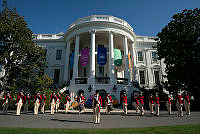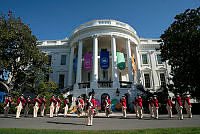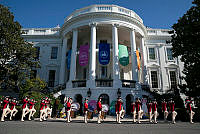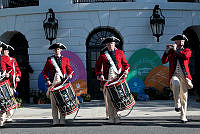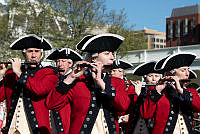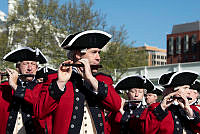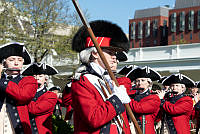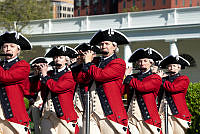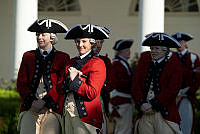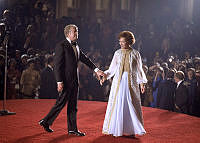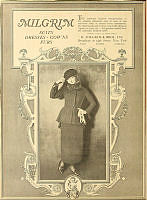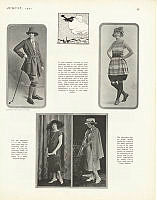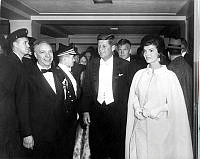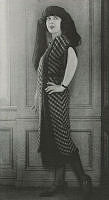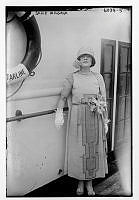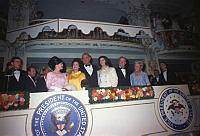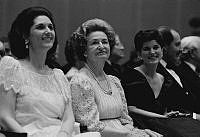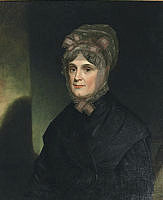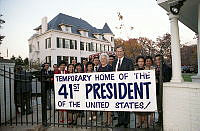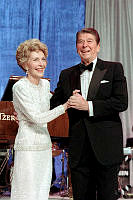Dressing Down for the Presidency
Thomas Jefferson's Republican Simplicity
Copyright © 2012 White House Historical Association. All rights reserved under international copyright conventions. No part of this article may be reproduced or utilized in any form or by any means, electronic or mechanical, including photocopying, recording, or by any information storage and retrieval system, without permission in writing from the publisher. Requests for reprint permissions should be addressed to books@whha.org
The new British minister to the United States was outraged. Within a few weeks of Minister Anthony Merry’s arrival in Washington, he was reporting to his foreign office in London what he perceived as breaches of diplomatic protocol, and topping his list of grievances were complaints regarding President Thomas Jefferson’s appearance. Merry had accompanied Secretary of State James Madison to the President’s House on November 29, 1803, to present his credentials to Jefferson. As Merry understood this to be an official occasion, he arrived in full diplomatic uniform, blue dress coat with gold braid, white breeches and white silk stockings, a plumed hat and dress sword. When President Jefferson shuffled into the room in “slippers down at the heels” and coat, breeches, shirt, and woolen stockings that to Merry displayed “utter slovenliness,” he felt that not only had he been deliberately insulted but that the insult extended to his sovereign and his country.1
In the continued retelling of his initial interview with the president, Merry found eager listeners, especially among the Federalist opposition party, and so the story grew. One New England Federalist had Jefferson greeting Merry in dressing gown, slippers, and a nightcap—well, perhaps not the nightcap, he conceded, but still he was sure that the British minister was not impressed with this display of “Democratic Majesty.”2 Other Federalists were quick to share their own impressions. Senator William Plumer of New Hampshire, when making his first call upon the president, assumed that it was a “servant” who entered the room in an old brown coat and clothing that appeared soiled, woolen hose, and slippers without heels. Upon introduction he apparently covered his dismay but quickly concluded that certainly he dressed better than the first officer of the land.3

Minister Anthony Merry, painted by Gilbert Stuart, represented Britain in the young American republic. He was famously received by Jefferson in casual attire, which offended the diplomat and appeared as an insult to his king.
Ever since Thomas Jefferson’s inauguration as third president of the United States in March 1801, divergent opinions had circulated regarding the style and personal image he brought to the office. The presidential protocol established by George Washington and then John Adams followed some traditions of the British court but with American moderation. Still Jefferson was uncomfortable, even alarmed, at what he believed to be monarchical customs in the presidential office. Following the extremely contentious and polarizing politics of the 1790s and with his defeat of John Adams in the election of 1800, Jefferson came to office intent upon placing a stamp on the American government that reflected his idea of true democratic-republicanism. The newly elected president used his inaugural ceremony as an initial demonstration of his egalitarian ideas. Rather than use a carriage, he chose to walk the short distance from where he was staying at Conrad and McMunn’s boardinghouse to the still unfinished Capitol. This may have taken on the appearance of a small, improptu parade, as he was joined by some supporting members of Congress and the Alexandria militia. Edward Thornton, the British attaché who preceded Anthony Merry, sent his observations on this republican “performance” to the Foreign Office in London and noted that Jefferson proceeded to the Capitol “on foot, in his ordinary dress.”4 Unfortunately, Thornton gave no detail of what comprised his “ordinary dress,” nor did the local newspaper coverage. Local reporters were more respectful of the ceremony itself but stated only that the new president presented himself as a “plain citizen with no distinctive badge of office.”5
Jefferson’s supporters lauded his “republican simplicity,” while detractors maintained that his appearance was contrived and politically motivated. British Minister Merry’s young attaché, Augustus John Foster, agreed with the Federalist opposition that even though the president “affected to despise dress,” in reality “Mr. Jefferson knew too well what he was about.” Foster based this opinion upon his knowledge of Jefferson’s background. As a member of the Virginia landed gentry, he was, in Foster’s estimation, an American “aristocrat.” Moreover, Foster knew that Jefferson had lived five years in Paris representing the United States as minister plenipotentiary at the Court of Versailles, a position that had afforded him the opportunity to interact with members of the French aristocracy and participate in some of Paris’s finest intellectual salons. In addition, he had been presented at the British Court of St. James’s when on a diplomatic trip to London. Jefferson’s ability to circulate within the society of France’s ancien régime with its demands of impeccable dress and demeanor convinced Foster that Jefferson “was playing a game” and that the purpose of this game was to appeal to the “greater mass” within the American polity.6

Thomas Jefferson, painted in a black coat on the eve of the presidential election of 1800 by Rembrandt Peale. The candidate is shown in black, the style of his hair in the new Titus mode, a neoclassical conceit first made famous by the French actor Talma as Titus in Voltaire’s Brutus in 1790.
Portraits of Jefferson made prior to his election to the presidency support Foster’s hypothesis by consistently depicting a well-groomed and fashionably dressed gentleman-statesman. The earliest extant portraits date to his years in Europe and show him wearing the latest styles in coats and waistcoats with his hair formally dressed and heavily powdered. Jefferson’s preference for the rigors of hairdressing over the fashionable wig was noted by Abigail Adams. She observed, “His Hair too is an other [sic] affliction which he is tempted to cut off. He expects not to live above a Dozen years and he shall lose one of those in hair dressing.”7 The only slight deviation is in a small portrait by artist John Trumbull that was created as a gift for Jefferson’s eldest daughter, Martha. Jefferson still appeared in a frock coat with the fashionable high collar, but the powder was brushed from his hair to reveal its natural coppery red color and, though pulled back into the queue, the sides were not dressed into curls. This less formal, more Americanized Jefferson was repeated in a portrait by Philadelphia artist Charles Willson Peale that was made following Jefferson’s return to the United States and his acceptance of the office of secretary of state. These pre-presidential portraits recorded the evolution of Jefferson’s self-fashioning from diplomat to a less formal look more in keeping with American taste and expectations of gentlemanly style.

A mature Jefferson was painted in 1791 by Charles Willson Peale. He is shown ten years before his presidency, while secretary of state to President Washington. The fuller face of maturity, and the casualness of the hair brushed back show an older man dressed in an American style with a coat of dark blue worn over a buff waistcoat, a popular color combination following the Revolution.
Vice President Jefferson continued to keep pace with American ideas of fashion, as a portrait by the young Philadelphia artist Rembrandt Peale, son of Charles Willson Peale, showed him on the eve of the election of 1800 dressed in a black coat and waistcoat. His hair was lightly powdered, clipped, and brushed forward around his face in the classically inspired style then fashionable in this age of neoclassicism. The portrait indicates that Jefferson could have chosen the increasingly popular black suit for his first inaugural and followed the precedent established by President Washington as recorded in the John Heath engraving taken from the full length oil painting by Gilbert Stuart, painted in 1796 and then engraved in London in 1800. However, as no one mentioned him dressed in black, as they would on subsequent official occasions and at his second inaugural, it seems likely he bypassed the suit from Peale’s portrait in favor of very simple day wear with even less sophistication than the black suit.

1796 portrait of George Washington by Gilbert Stuart, which had been made available to the public with the engraving by John Heath in 1800.
As the election of 1800 moved forward and interest in Jefferson increased, Peale’s portrait served as the model for various prints created for public sale. Once his election was finally confirmed in February 1801, two Philadelphia engravers, David Edwin and Cornelius Tiebout, competed to be the first to issue full-length images of the new president. Each advertised an accurate portrayal even though neither print was taken directly from life. Obviously both Edwin and Tiebout used the visage delineated by Rembrandt Peale. To make it a full-length figure, it is possible that the engravers had seen the tall, slender vice president in Philadelphia prior to the federal government’s move to the new capital of Washington City in late 1800. These prints are informative even though not from life portraits, as they give the engravers’ impressions of Jefferson and what they felt would meet the expectations of the buying public.8

Artist John Trumbull completed an image for a close friend of Jefferson’s residing in London. Again the artist paints him in fashionable day wear but with very formally dressed and powdered hair for a portrait that would be shown to members of London society. Though the United States might share many of the same clothing styles popular in London and Europe, a more casual interpretation of fashion was often preferred by Americans.
White House Collection/White House Historical AssociationBoth Edwin and Tiebout dressed Jefferson in the three-piece black suit with smooth black stockings implying silk. Each placed his figure in the traditional setting borrowed from European state portraits with columns, massive drapery, and fine carpet, and both implied statesman and scholar with books, writing instruments, and a globe of the world. Tiebout’s print goes beyond Edwin’s, however, in its description of Jefferson by including a bust of Franklin and a scientific instrument, a static electrical machine. He specifically identified one of Jefferson’s most notable achievements by placing a copy of the Declaration of Independence in his hand. With this indication of both scholarship and science, advertisements for the Tiebout print promised Jefferson presented as a “philosopher and a statesman”; the Edwin print advertised “the man of the people.”9
These images invite comparison to the John Heath print of Washington. In fact, the Edwin print was advertised as in a size compatible with the popular Washington portrait. The image of George Washington as captured by Stuart would have met Minister Merry’s expectations—understated, modest, but nevertheless appropriate for a republican head of state. Had Jefferson appeared dressed in black, his initial meeting with Minister Merry could have begun more amicably.
The black suit was quickly becoming a staple for the well-dressed man. In the Western world, black had been long associated with the ecclesiastic and the scholar. It represented sobriety and stability and by the eighteenth century had become a practical choice for the middle-class professional man. An English traveler visiting France in the 1780s noted the use of black by those of “small or moderate fortune” for its practicality, as the black suit combined with black rather than white silk stockings withstood the dirt from the Paris streets. Thus the traveler also recognized that black could become a visual dividing line within society between those of large fortunes and those of more modest means.10 Nevertheless, black prevailed. Through its practicality, it became egalitarian, and by the end of the 1790s was appearing regularly in the portraits of gentlemen, especially in the United States.

In a world hungry for illustration, before the camera’s introduction, engravings in black and white sold well on the popular market. Portraits of statesmen were especially favored, as this of Thomas Jefferson by Cornelius Tiebout, engraver of Philadelphia. He copied the head from the Rembrandt Peale portrait of 1800 then gave Jefferson a black suit and a formal setting that was comparable to the 1796 portrait of George Washington by Gilbert Stuart, which had been made available to the public with the engraving by John Heath in 1800.
The similarities in the prints of Jefferson and of Washington are obvious, but there are subtle distinctions as well. Both figures stand before massive draperies and columns and with props of books and papers. Both wear black suits and black stockings. However, a notable object in the Washington portrait absent in both prints of Jefferson is the elegant dress sword. Washington holds a handsome sword in his left hand, as he raises his right hand in the classic oratorical gesture. A contemporary viewer would have understood the significance of the dress sword as a mark of power and therefore reserved for the gentleman. Perhaps there was deliberation in Tiebout’s choice of placing a copy of the Declaration of Independence in Jefferson’s hand with his gesture directed toward it.
An even more subtle distinction was in the footwear of each figure. Washington’s shoes were the established, low-cut style with ornate buckles; in contrast, Jefferson’s came to his ankle, rather like a short boot, and what was more important, they laced with strings rather than buckled. An extant invoice backed by Jefferson’s own accounting records shows that the Washington shoemaker, John Michin, made him a pair of “bootees” early in 1801 for $6.00 and included a pair of silk strings for 25 cents.11
Jefferson by no means originated the practice of laces as opposed to buckles. A British diarist, Sir Nathaniel Wraxall, listed the replacement of buckles with strings in his lament of the changes that began taking place in men’s clothing during the late eighteenth century. He placed the blame on the revolution in France along with the ideas of social leveling being advanced in England during the 1790s. In his words, “Dress never totally fell till the era of Jacobinism and of equality in 1793 and 1794. It was then that pantaloons, cropped hair, and shoe-strings, as well as the total abolition of buckles and ruffles, together with the disuse of hair-powder, characterized the men.”12 Obviously Jefferson chose to support the ideology attached to such practical footwear adopted from laboring classes.

Artist John Trumbull painted a small portrait in 1788 as a gift for Jefferson’s eldest daughter Martha. Jefferson was still serving in France and is dressed in fashionable gentleman’s daywear. It is notable that Trumbull shows Jefferson with his hair not powdered and formally dressed in this very personal portrait.
Despite the growing popularity in Europe and England, the choice of strings over buckles was novel enough in the United States to draw commentary by Jefferson’s political opponents. A brief editorial in New York’s Commercial Advertiser of July 1802 leveled the familiar charge that Jefferson was deliberately attempting to appear different: “In every age of the world, rulers and philosophers have made themselves remarkable for the affectation of some singularity,” and, the editorial then goes on to say, “Our philosophic President chooses to have his singularities as well as European kings—He prefers shoe-strings, when other folks wear buckles.”13 Another Federalist wrote that the president’s shoes “closed tight round his ankles, laced up with neat leather strings and absolutely without buckles,” adding the supposition that buckles were “superfluous and antirepublican especially when he has strings.”14
At the beginning of his second presidential term in 1805, Jefferson had reasons to feel optimistic. He was reelected in a landslide victory. The public approved his administration’s successful negotiation for the purchase of the port city of New Orleans that ultimately included all of the Louisiana Territory. The country had doubled in size, the port of New Orleans was secure, and the United States was prospering economically.
Feeling confident and optimistic, Jefferson presented himself very differently when asked to sit a second time for Rembrandt Peale. Rather than the sedate black suit and neatly powdered hair of Peale’s first portrait of 1800, he chose a red coat with a high, rolled collar and left his hair loose with little, if any, powder. Most notable is the fur-lined cape that he wrapped about him as he stared directly at the viewer. The intent was to feature the painting in a grand illumination at the Peale family’s Philadelphia museum on the eve of his second inauguration. Jefferson must have been aware of this plan as he chose his clothing.
The fur-lined cloak had an interesting history. Jefferson’s close friend Margaret Bayard Smith wrote a brief reminiscence of being loaned a fur cloak following a dinner party at the President’s House in the winter of 1805. She was doubly excited to be sent home in a fur belonging to Jefferson that she knew had been presented to him by Polish aristocrat and Revolutionary War hero, Tadeusz Kosciuszko.15 Existing correspondence supports that Kosciuszko presented Jefferson a “fur” when he left the United States in May 1798 to return to Europe, and subsequently Jefferson made references to his “wolf-skin pelisse” but without connecting it directly to the gift from Kosciuszko. The term “pelisse” designated an overgarment, usually fur-lined, that could be fitted or shaped as a cape. It was a Jefferson family letter that later identified this garment as “Kosciusko’s wolf skin pelisse.”16

Rembrandt Peale painted a second portrait of Jefferson in late January 1805. Painted at the White House, the portrait shows President Jefferson as he appeared at the conclusion of a very successful first term in office. At the peak of his popularity and with the knowledge that he had won a landslide victory for reelection, Jefferson posed for this formal portrait in a somewhat unconventional manner with his hair not dressed and covering his red coat with a large, fur-lined cape.
Jefferson maintained a long correspondence with Kosciuszko and called him “as pure a son of liberty, as I have ever known.”17 During the war for independence from England, Kosciuszko had contributed his skills as a military engineer to the American cause and then had led Polish peasants in a failed attempt against invading armies that ultimately resulted in the partitioning of Poland. Of course most viewers would not have been aware of the history connected to this garment; nevertheless, it lends an unconventional bearing to an American portrait in which most gentlemen never ventured far beyond the fashionable coat, waistcoat, and appropriate linen. In a broader comparison, a European ruler would have been draped with ermine; Jefferson sits wrapped in wolfskin.
Jefferson never responded directly to observations on his appearance. In fact, he was well into retirement when he began to reflect over his life in public service and set down from notes and memory his views on the early years of the republic. He maintained that “the contests of that day were contests of principle, between the advocates of republican, and those of kingly government.” He believed that if he and his political allies had not confronted the “monarchists,” “Our government would have been, even at this early day, a very different thing from what the successful issue of those efforts have made it.”18 Jefferson had not been alone in the concern that the new nation might swing back to the more familiar forms of governance that relied upon the strength and control of a king with the support of an aristocracy. Certainly there were those outspoken in the belief that without a powerful executive, the United States could never stand either economically or politically against Britain and Europe. With such issues in debate, clothing might seem a trivial consideration and a strange way of underscoring an ideology, but by visually denying a pretense of wealth or elitism, Jefferson attempted to support his belief in democratic principles of meritocracy. To some this denial seemed false, and they agreed with Augustus John Foster that Jefferson was playing a game. Despite criticism, however, Jefferson was obviously pleased to report to Kosciuszko one year after taking office that “republicanism has recovered its ascendancy.”19
Jefferson never totally gave up the proper and egalitarian black suit. As mentioned, he was dressed in black for his second inauguration and reported in black for many of the dinner parties he held for members of Congress. yet the tales of his dressing down as president lingered. Even after Minister Anthony Merry had been recalled and reassigned to other diplomatic duties, he continued to tell the story of his American reception and the slovenly dressed president who sat and tossed a “down at the heel slipper” into the air and caught it on his toe.20














